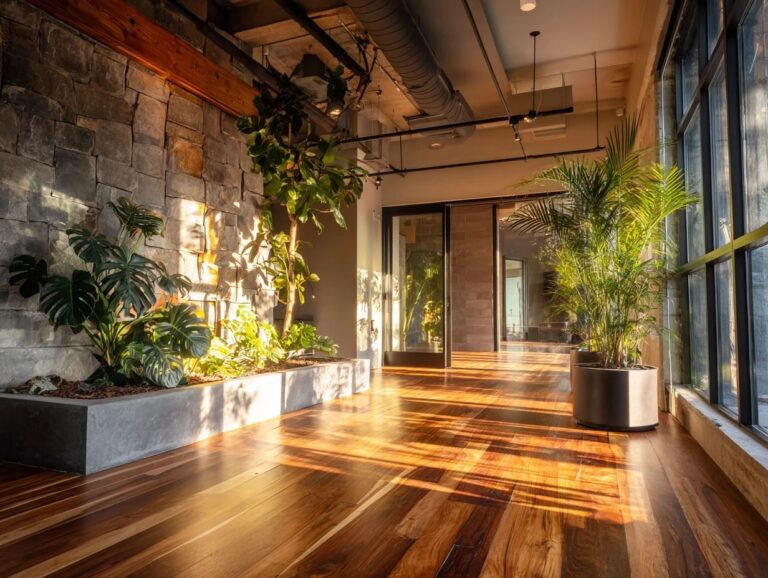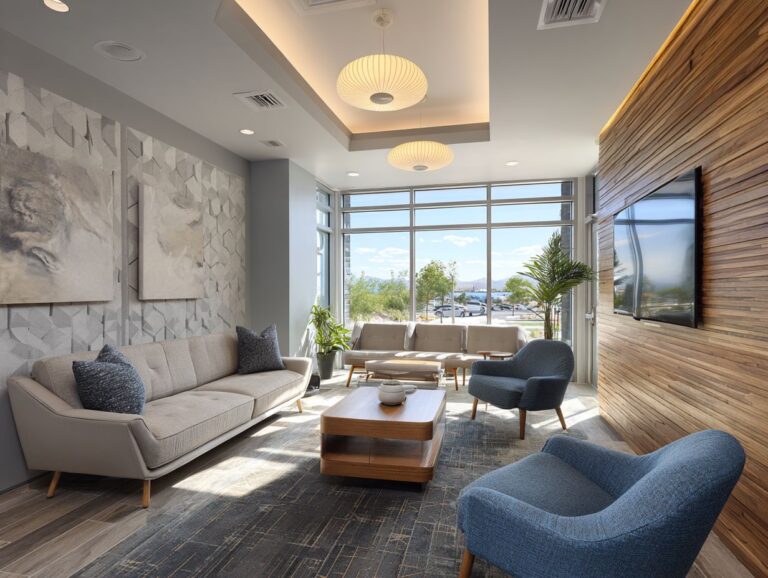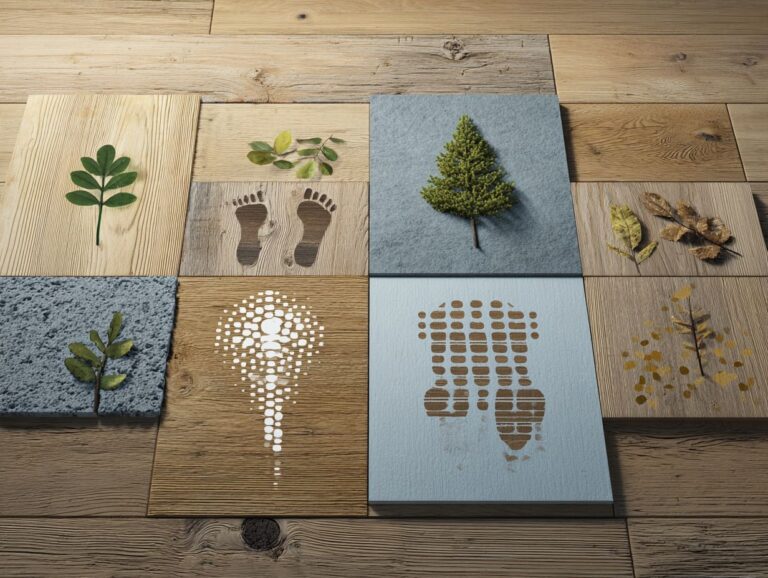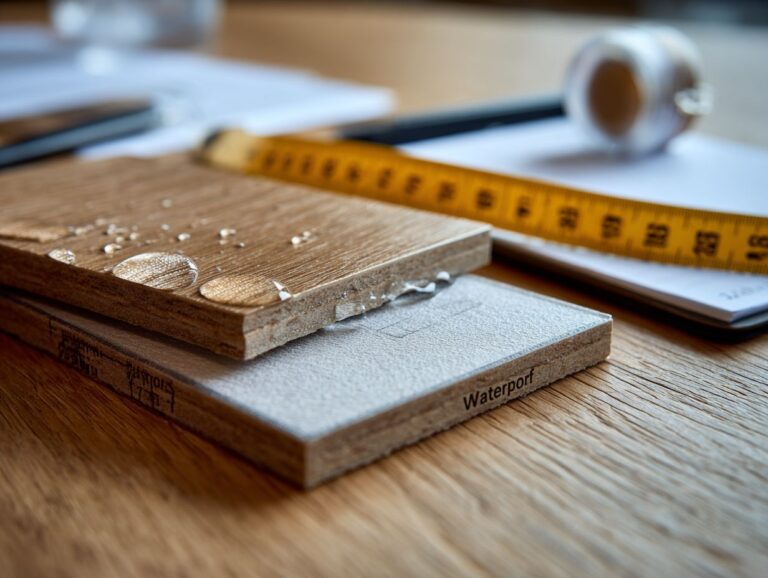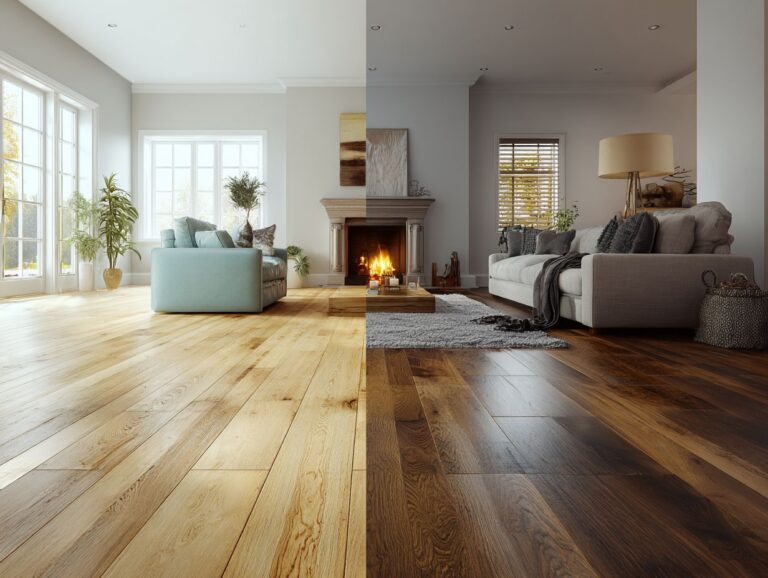Hallway and Stairs Flooring – High Traffic Solutions
Picking the best flooring for hallways and stairs in busy areas is important for appearance and durability. With a variety of flooring solutions available, including tile flooring and luxury vinyl plank, you can achieve a look that endures daily wear and tear. This article looks at the top choices for strong flooring, helping you achieve the ideal mix of looks and practicality for your busy home.
Key Takeaways:
Contents
- Flooring for Busy Areas and Industry Information
- Types of Flooring Materials
- Durability and Maintenance
- Design Considerations
- Installation Techniques
- Safety Features
- Cost Considerations
- Frequently Asked Questions
- What are some high traffic solutions for hallway and stairs flooring?
- What are the benefits of using hardwood for hallway and stairs flooring?
- Is laminate flooring a good option for high traffic areas like hallways and stairs?
- Can vinyl flooring handle heavy foot traffic in hallways and stairs?
- What type of tile is best for high traffic areas like hallways and stairs?
- How often do high traffic hallway and stairs flooring need to be replaced?
Importance of Flooring in Hallways and Stairs
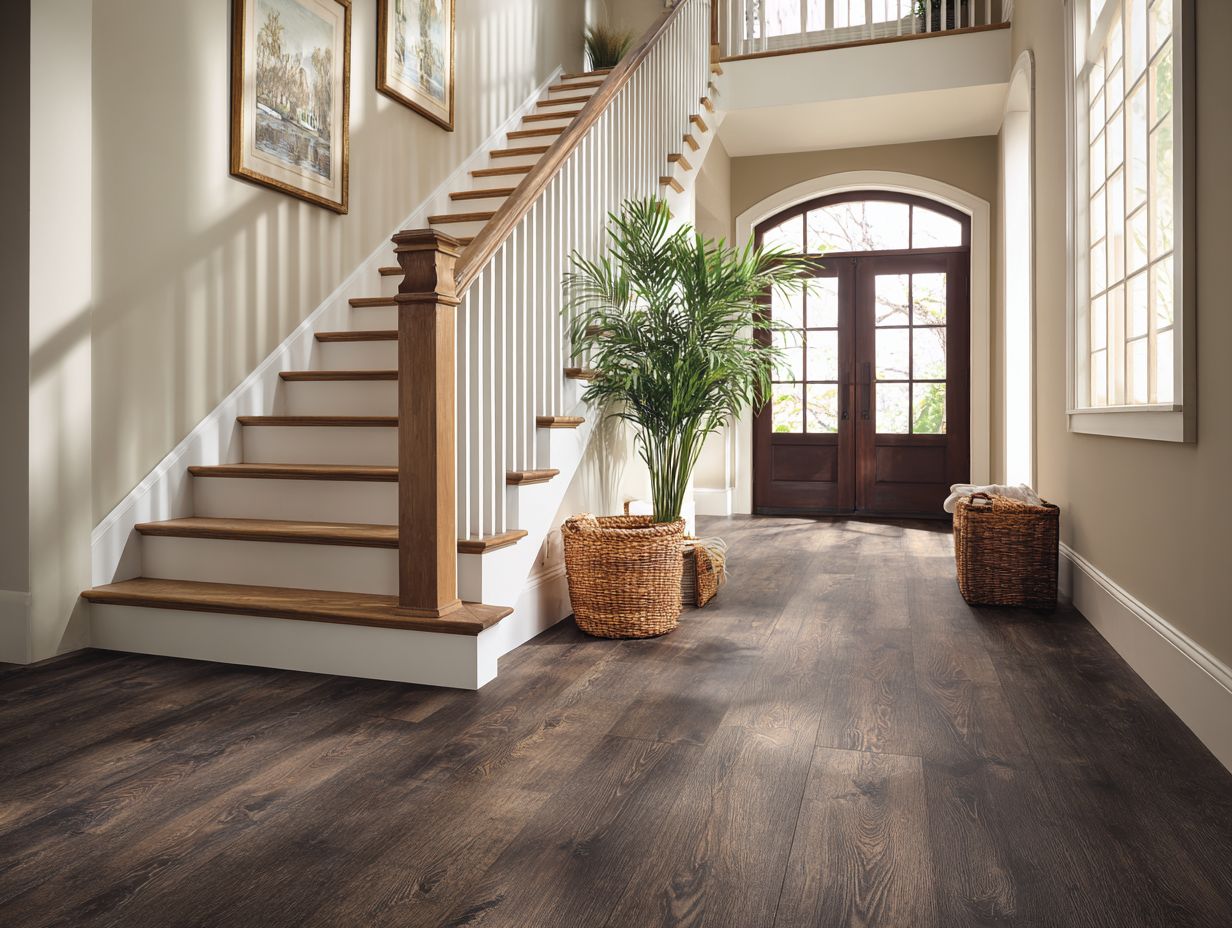
Hallways and stairs are critical transitional areas that endure significant wear and tear, necessitating durable flooring solutions.
Choosing flooring for these high-traffic zones requires careful consideration of slip resistance and ease of cleaning. Materials like vinyl or laminate are excellent for hallways due to their durability and minimal maintenance needs.
For stairs, rugs or non-slip runners can make them safer and more comfortable. Ceramic tiles work well for both areas because they last a long time and are easy to clean.
Opt for textured surfaces in busy hallways to prevent slips and stains, ensuring these spaces remain both stylish and safe for daily use.
Challenges of High Traffic Areas
Busy places have special problems like quick damage, dirt build-up, and regular upkeep needed for safety.
To address these challenges, consider using durable flooring materials like porcelain tile or luxury vinyl, which resist scratches and stains.
Regular deep cleaning with professional equipment can stop dirt from accumulating and improve safety.
Applying slip-resistant coatings can significantly reduce slip hazards.
- Establish a maintenance routine; for example, inspect areas weekly and schedule professional cleaning quarterly.
By selecting suitable materials and using a regular maintenance schedule, you can make your flooring last longer and create a safer space.
High Traffic Flooring and Industry Information
Flooring for Busy Areas and Industry Information
Durability and Industry Performance: Flooring Durability Ratings
Durability and Industry Performance: Industry Sales and Volume
Durability and Industry Performance: Category Specific Changes
The Flooring for Busy Areas and Industry Information data provides a detailed summary of flooring durability ratings and how the industry is doing in 2024. This information is important for people involved in the flooring industry, such as producers, sellers, and buyers, because it shows major trends and changes affecting sales and choices of products.
Durability and Industry Performance metrics reveal a 31% performance rating for wood flooring, indicating its resilience and popularity in high-traffic areas. Despite its strength, the data shows a 6.3% decline in ceramic tile volume, suggesting changes in consumer preferences or perhaps economic factors affecting its sales.
- Industry Sales and Volume: The flooring industry faces a 4.6% decline in total sales in 2024, reflecting broader market challenges. Sales reach $23.955 billion, with 17.206 billion square feet sold, illustrating the sector’s large scale despite decreased sales figures. This decline points to potential issues like reduced consumer spending or shifts in market demand.
Category Specific Changes highlight varying impacts across flooring types. Hardwood sales decline by 9%, possibly due to high costs or maintenance issues. In contrast, vinyl shows a moderate decline of 2.3%, indicating its continued popularity due to affordability and ease of installation. Laminate sales decrease by 7.5%, suggesting challenges in competing with other resilient flooring options.
The Flooring for Busy Areas and Industry Information Data shows that while some types of flooring remain strong and popular, the industry’s sales patterns are changing. Businesses might have to come up with new ideas or change plans to meet shifting customer choices and economic situations, making sure they stay strong in a tough market.
Types of Flooring Materials
Knowing about the different flooring materials helps you choose the best option for busy areas, particularly when considering both water resistance and style. For instance, kitchen flooring options offer insights into how these factors play a crucial role.
Hardwood Flooring
Hardwood flooring looks great and lasts a long time, though it needs proper upkeep to handle lots of people walking on it.
To keep hardwood floors looking their best, regular maintenance is essential. Start by sweeping or vacuuming weekly to remove dirt and debris that can cause scratches.
Each month, mop your floors with a damp mop and a hardwood floor cleaner to keep them shiny. Avoid too much water, as it can damage the wood. In places where many people walk, put on a protective layer every few years to maintain the durability of the surface.
Place rugs in entryways and high-traffic zones to further protect your flooring from wear and tear. Following these practices can significantly extend the life of your investment.
Laminate Flooring
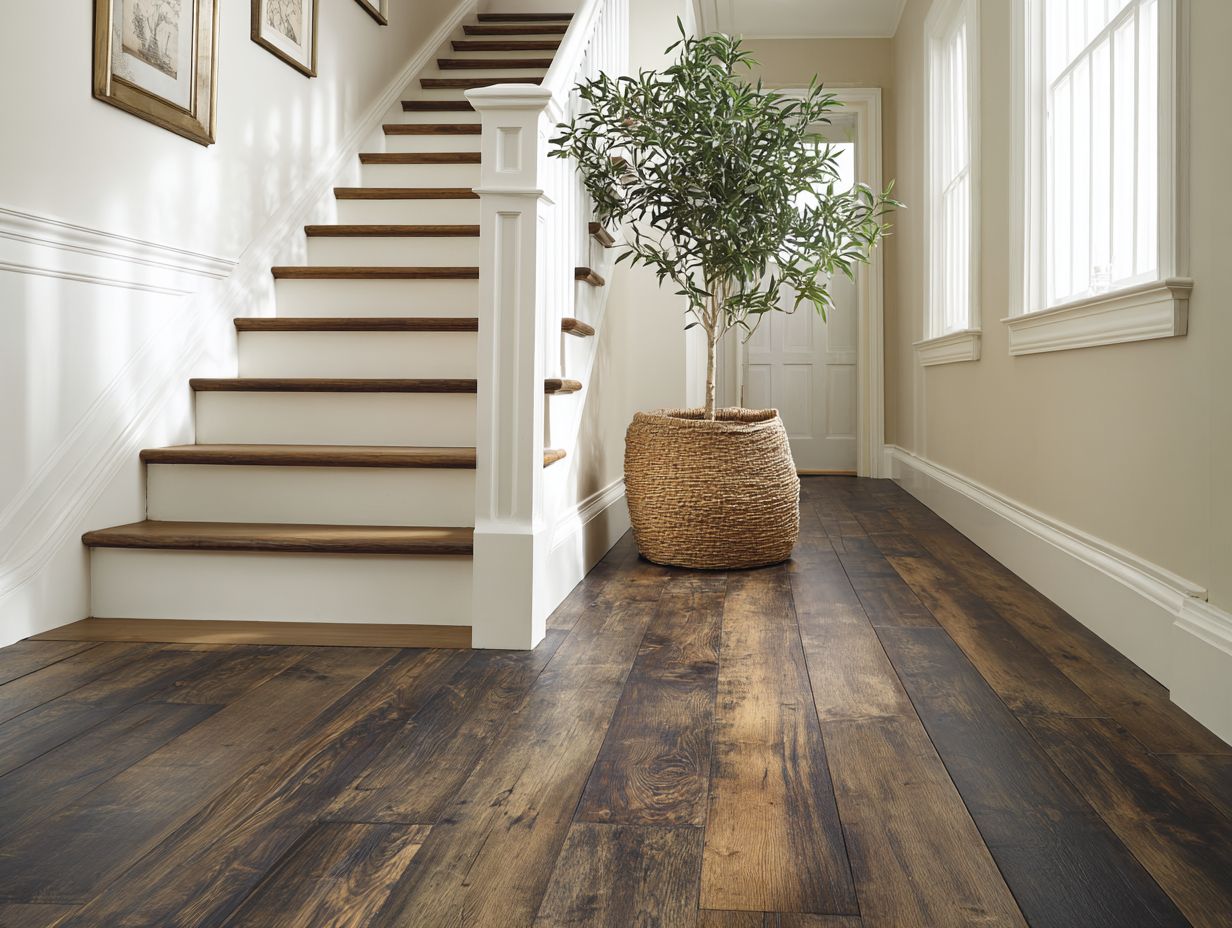
Laminate flooring provides a budget-friendly alternative that mimics the look of natural wood while being highly resistant to scratches and stains.
Its affordability makes it ideal for high-traffic areas in both residential and commercial settings. For instance, installing laminate in a busy living room or a retail shop can withstand daily wear and tear while maintaining its aesthetic appeal.
When selecting laminate, look for options with high AC ratings, such as AC4 or AC5, which indicate greater durability. Consider choosing water-resistant varieties for spaces prone to moisture, like kitchens or bathrooms, ensuring longevity and ease of maintenance.
Vinyl Flooring
Luxury vinyl plank is gaining popularity for its exceptional moisture resistance and ease of installation in various settings.
It’s particularly suited for kitchens and bathrooms, where water exposure is common.
Many appreciate that luxury vinyl can mimic the look of wood or stone, providing aesthetic flexibility.
For installation, use a simple click-lock system or glue-down method, both manageable for DIYers.
To maintain its quality, sweep or vacuum regularly, and use a damp mop with a mild cleaner.
Steer clear of strong chemicals to keep your flooring looking great over time.
Tile Flooring
Tile flooring, offered in porcelain and ceramic, is known for being long-lasting and easy to clean, which makes it perfect for busy areas.
Besides being resistant to scratches and stains, tile flooring can improve the look of entryways and hallways.
For example, consider using larger tiles to create the illusion of a more expansive space, or opt for a mix of matte and glossy finishes to add depth. Using matching or contrasting grout colors can improve the overall appearance.
Remember to place area rugs to make the space more comfortable and to prevent slipping, adding safety in a busy entrance.
Carpet Flooring
Carpet flooring offers comfort and sound absorption, but may require more frequent maintenance in high-traffic zones to uphold its appearance.
In high-traffic areas, consider using low-pile carpets which are more durable and easier to clean. It’s also wise to place area rugs or mats at entry points to trap dirt and moisture before they reach the carpet.
Vacuum your carpet at least two times a week and get it cleaned by professionals every 12 to 18 months to make it last longer. If safety is a concern, opt for carpets with low-VOC adhesives and backing materials, which contribute to better indoor air quality.
To sum up, combining comfort with practicality makes your flooring both welcoming and useful.
Durability and Maintenance
Choosing durable and easy-to-clean flooring is important for surfaces in busy areas to last longer.
Wear Resistance
Wear resistance is a critical factor in flooring choice, influencing how well materials hold up under constant foot traffic.
For long-lasting use, look at options such as commercial-grade luxury vinyl planks. These typically have a thicker top layer, often 20 mil or more, making them good for places with heavy foot traffic.
Options such as Mohawk’s SolidTech are designed for resilience, while Shaw’s Floorte offers advanced scratch protection. Bamboo flooring, like Cali Bamboo, provides natural strength and moisture resistance, perfect for both homes and businesses.
When evaluating wear resistance, assess the manufacturer’s ratings and look for warranties that reflect confidence in performance, often ranging from 15 to 30 years.
Ease of Cleaning
Flooring that is easy to clean can significantly reduce maintenance time and costs, especially in high-traffic environments.
Here are cleaning methods suited for various types of floors.
- For hardwood, use a microfiber mop with a pH-balanced cleaner like Bona Hardwood Floor Cleaner to avoid damage.
- If you have tile, employ a steam mop that sanitizes while deep cleaning grout lines.
- For carpets, a carpet shampooer with carpet cleaner solution will refresh your floors and remove stains.
Regularly sweeping or vacuuming can prevent dirt buildup and prolong the life of all flooring types. Using these methods keeps your space clean and inviting.
Longevity of Different Materials
Knowing how long various flooring types last can help you choose the best option for busy areas.
Hardwood floors can last from 20 to 100 years, depending on the type of wood and maintenance, making them a durable choice for many years. In contrast, laminate typically has a lifespan of 15 to 25 years, while luxury vinyl can endure around 10 to 20 years.
Tile flooring stands out, often lasting over 50 years with proper care. When deciding, consider the room’s use; for example, kitchens might benefit from durable tile, whereas living rooms may favor the aesthetic warmth of hardwood.
Always factor in maintenance costs, as some materials require more upkeep than others.
Design Considerations
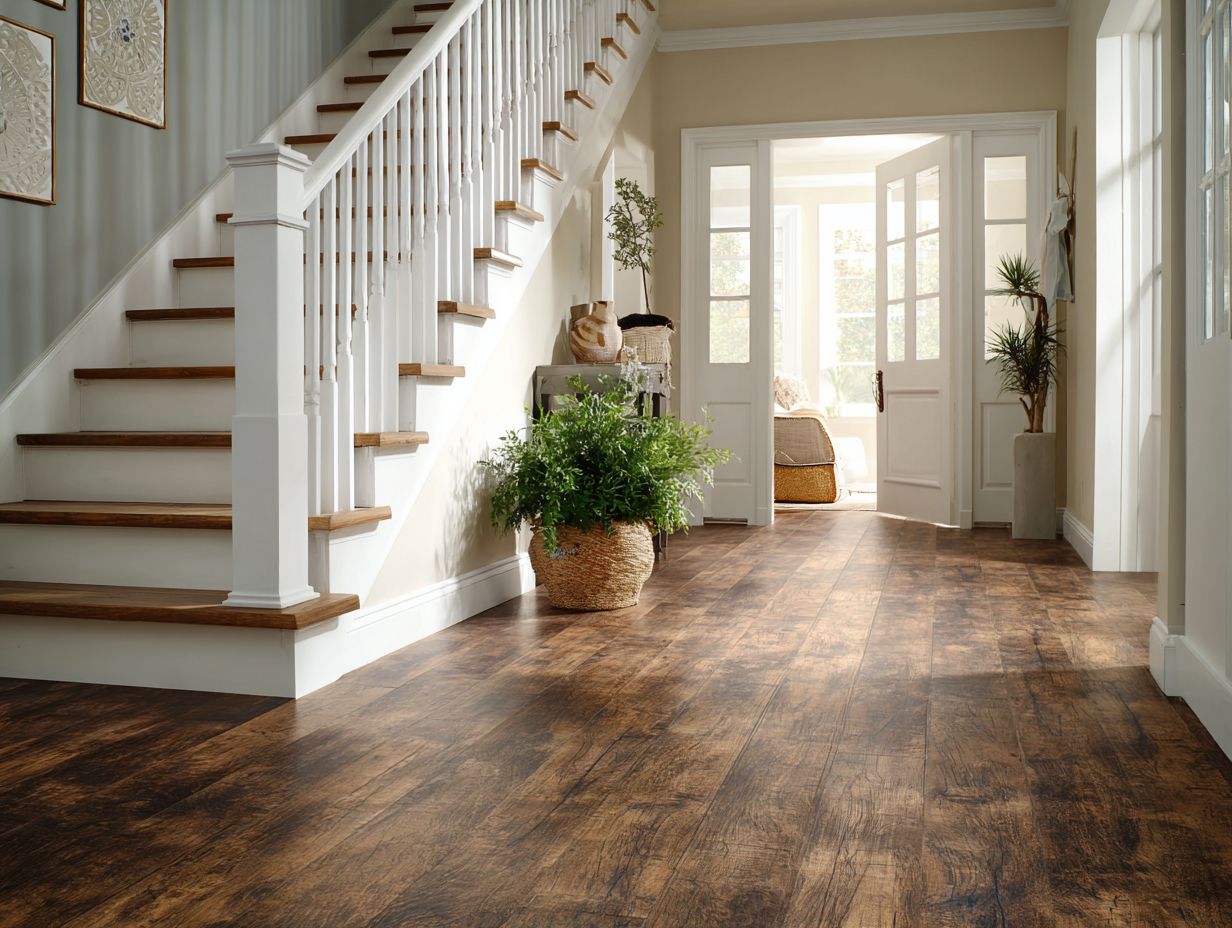
Choosing the right flooring is important for both how it looks and how it holds up in places where many people walk.
Color and Texture Options
Picking the right colors and materials can improve the look of floors and make rooms seem bigger or more welcoming.
To select the ideal colors and textures, consider the room’s purpose.
For high-traffic areas like hallways, opt for durable, dark-colored flooring like charcoal or deep navy, which hides dirt well. In contrast, lighter colors like soft beige or pale gray can brighten living rooms, giving an airy feel.
Textured finishes, such as a lightly brushed wood or ceramic tiles with a matte finish, add depth without being overwhelming. To create a unified appearance, make sure the colors match your current furniture and decorations.
Patterns and Layouts
The layout and patterns of flooring can significantly influence the perception of space, drawing attention and creating visual interest.
-
Two popular flooring layouts are herringbone and diagonal patterns, each offering a unique aesthetic.
-
Herringbone, recognized for its zigzag design, can add motion and a polished appearance, ideal for small spaces. To implement, start by measuring your area, ensuring that each piece aligns perfectly for a seamless look.
-
On the other hand, diagonal patterns can elongate a room visually, often used in larger spaces. To maximize this effect, lay your tiles or boards at a 45-degree angle from the walls.
-
Both methods can improve the look of your interior and give it a unique style.
Installation Techniques
Proper installation techniques are essential for flooring to be durable and effective in high-traffic areas.
Preparation of the Subfloor
Getting the subfloor ready properly is an important part of installing flooring, which affects how long the floor lasts and how well it works.
- Start by testing the moisture levels using a moisture meter; values should be below 12% for wood and 4% for concrete.
- Next, identify any uneven areas with a level tool, and if necessary, use a self-leveling compound like Henry 555 for quick repairs.
- Make sure the area is clean and clear of any dirt before starting. Apply a vapor barrier if moisture is a concern, helping to protect your new flooring investment.
- This detailed preparation is important for getting long-lasting, attractive results.
Proper Installation Methods for Each Material
Different flooring types require particular methods for installation to make sure they look good and function effectively in crowded areas.
For hardwood flooring, start by acclimating the planks in the room for at least 48 hours. Use a moisture meter to check moisture levels before proceeding.
- For a glue-down installation, apply adhesive with a notched trowel and lay the planks tightly together.
- In contrast, laminate flooring requires a foam underlayment for sound absorption and can be installed as a floating floor, allowing for easy removal.
Always use the right saw for the flooring, such as a miter saw for exact cuts.
Safety Features
Including safety features in flooring can prevent accidents in crowded areas, making it safer for everyone.
Slip Resistance
Ensuring adequate slip resistance in flooring materials reduces the risk of accidents, particularly in wet or high-traffic areas.
To effectively assess slip resistance, refer to testing standards like ASTM C1028 or DIN 51130, which measure co-efficient of friction.
For optimal safety, consider flooring materials such as:
- Textured porcelain tiles
- Rubber flooring
- Vinyl with a high slip-resistance rating
Textured porcelain tiles improve grip, are long-lasting, and come in different styles. Rubber flooring works well in places like gyms and play areas because it grips well and cushions falls. Choosing the appropriate material can greatly improve safety and ease of use.
Edge and Corner Treatments
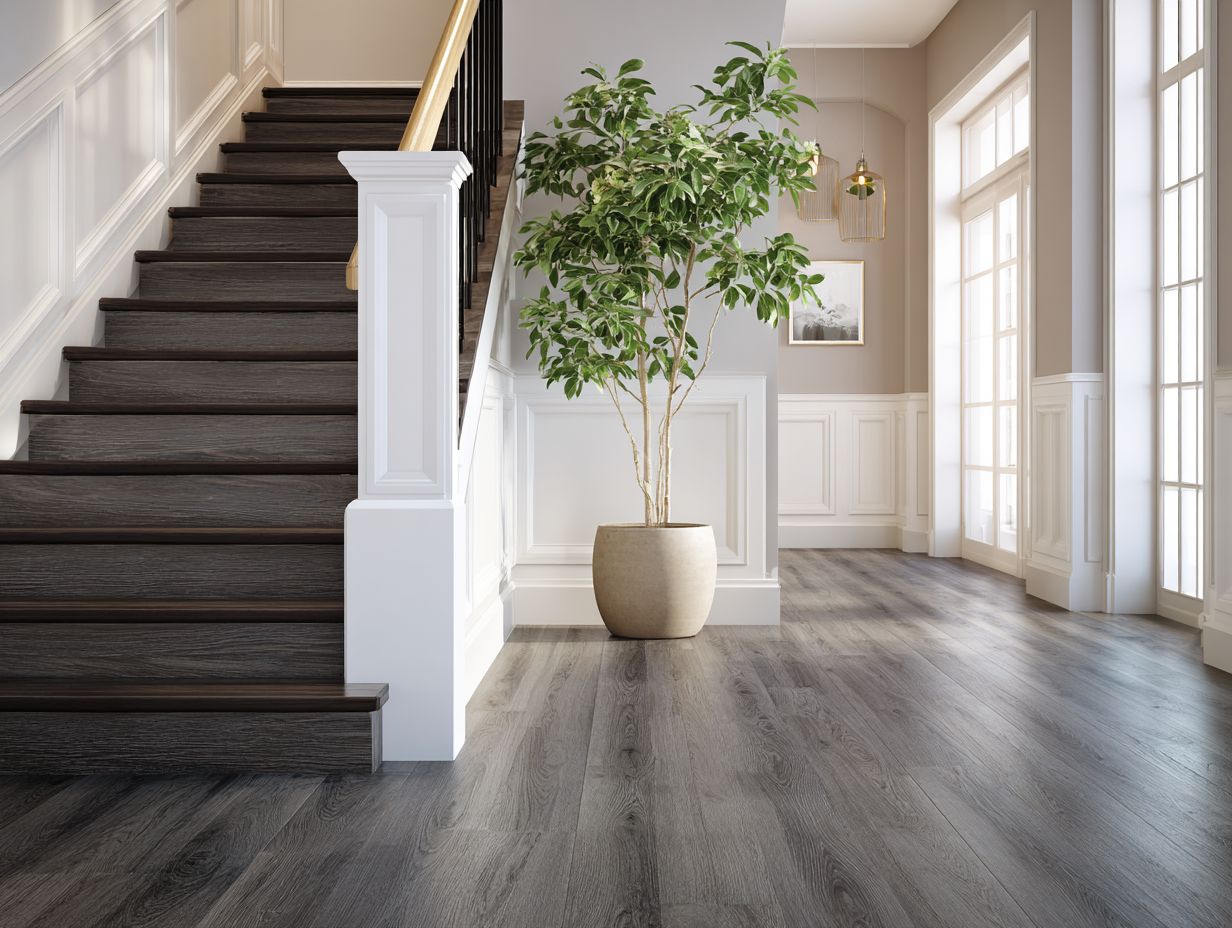
Using suitable edge and corner designs can reduce the risk of tripping and make floors safer in high-traffic areas.
For effective treatments, consider rounded edges, which provide a smooth transition and are ideal for high-traffic zones like retail spaces.
Corner protectors help prevent injuries from sharp edges in hospitals and schools.
Materials like rubber or vinyl offer durability and easy maintenance, while options like carpet corner guards blend seamlessly with soft flooring.
Reviewing each treatment’s suitability for the environment and foot traffic can greatly improve safety while keeping the design intact.
Cost Considerations
Thinking about your budget is important when choosing flooring that is affordable, long-lasting, and looks good. For an extensive analysis of this trend, our complete guide to hardwood flooring types and species explores a variety of options that meet these criteria.
Budgeting for High Traffic Solutions
When budgeting for flooring, it’s essential to account for initial installation costs along with long-term maintenance expenses.
Start by comparing materials: hardwood typically ranges from $3 to $12 per square foot, while laminate can cost between $0.70 and $3.
If you choose hardwood, expect to pay more to refinish it every 5-10 years, costing around $1.50 per square foot. In contrast, laminate is less expensive to maintain, requiring only periodic cleaning.
To cover a 1,000-square-foot space, hardwood floors may initially cost between $3,000 and $12,000. In contrast, laminate flooring ranges from $700 to $3,000, making laminate a more affordable option for most homeowners.
Long-term Investment vs. Short-term Solutions
Evaluating flooring as a long-term investment rather than a short-term solution can lead to better choices that reduce overall costs.
High-quality flooring materials, such as hardwood or luxury vinyl tiles, may have a higher upfront cost but offer superior durability and aesthetic appeal.
For instance, hardwood flooring can last over 50 years with proper maintenance, potentially saving money on replacements. In contrast, cheaper laminate options might need replacing within 10-20 years.
Using resources like HomeAdvisor can help you assess long-term costs by providing estimates for installation and maintenance.
Selecting the right materials for their durability means your spending on flooring is worthwhile and increases the worth of your home.
Frequently Asked Questions
What are some high traffic solutions for hallway and stairs flooring?
Some high traffic flooring solutions for hallways and stairs include hardwood, laminate, vinyl, and tile. These materials are durable and can withstand heavy foot traffic.
What are the benefits of using hardwood for hallway and stairs flooring?
Hardwood is a popular choice for high traffic areas due to its durability and classic look. It can withstand heavy foot traffic and is easy to clean and maintain. It also adds a touch of elegance to any home.
Is laminate flooring a good option for high traffic areas like hallways and stairs?
Yes, laminate flooring is a great option for high traffic areas. It resists scratches and stains, making it perfect for hallways and stairs. It is also cost-effective and easy to install.
Can vinyl flooring handle heavy foot traffic in hallways and stairs?
Yes, vinyl flooring is a great option for high traffic areas. It can resist water and lasts a long time, making it a useful option for hallways and stairs. It is also available in a variety of designs and styles.
What type of tile is best for high traffic areas like hallways and stairs?
Porcelain or ceramic tiles are the best options for high traffic areas. They are durable and resist scratches and stains, which makes them ideal for hallways and stairs. They also come in a variety of colors and patterns to suit any style.
How often do high traffic hallway and stairs flooring need to be replaced?
The frequency of replacing your flooring depends on the material used and the amount of foot traffic it receives. Usually, strong materials such as hardwood, laminate, vinyl, and tile can last many years before they need to be changed.

